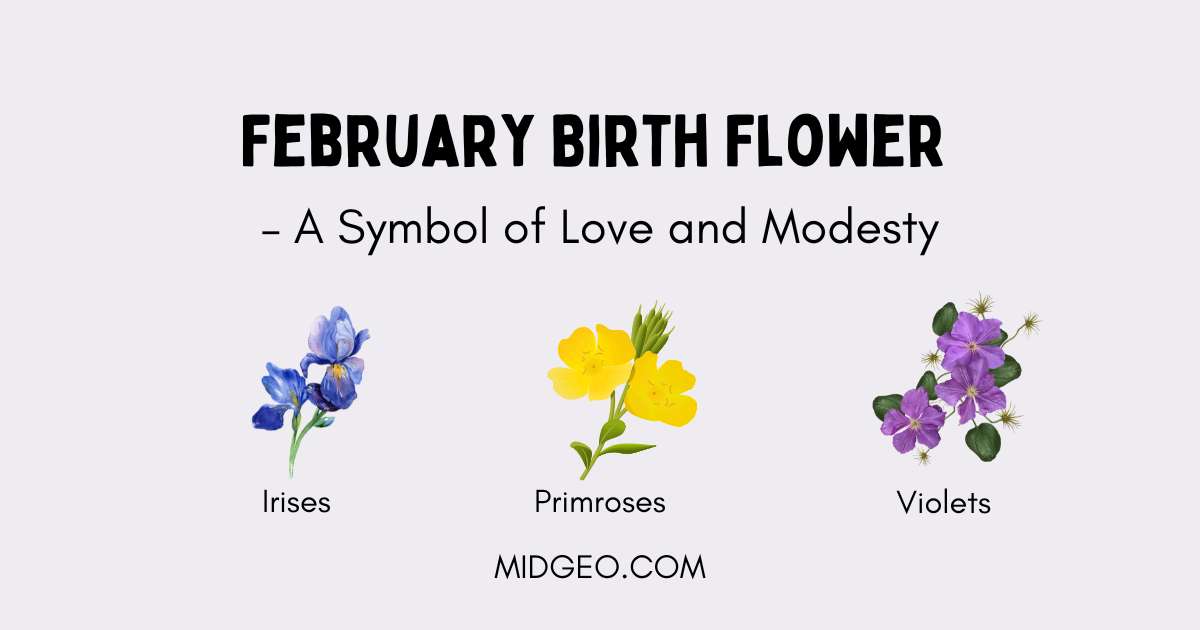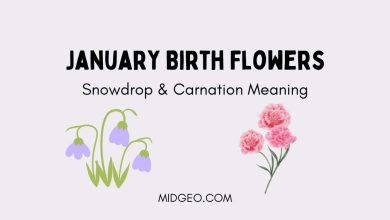February Birth Flower – A Symbol of Love and Modesty

February Birth Flowers: The Beauty and Symbolism of Violets, Primroses, and Irises. Flowers have a timeless charm, each holding unique meanings that connect us to nature and traditions.
For February, the birth flowers—violet, primrose, and iris—are a vibrant celebration of love, hope, and renewal.
Whether you’re looking to create a meaningful bouquet, design stunning artwork, or simply learn about these lovely blooms, this guide dives deep into their beauty and symbolism.
Let’s explore the fascinating world of February birth flowers and how they add a personal touch to life’s moments.
What is February Birth Flower?
February is a month often associated with love, thanks to Valentine’s Day. But did you know it also boasts two stunning birth flowers?
These blooms, violet and primrose, hold a special place in the hearts of February-born individuals, representing beauty, resilience, and affection. Let’s explore these floral symbols and uncover their unique significance.
The Two Official Flowers of February
February is unique in having two official birth flowers: the violet and the primrose. Each flower brings its own charm and symbolism, making February a month that celebrates both modesty and cheerfulness.
Violet – The Quintessential February Birth Flower
The violet is the more widely recognized February birth flower. Its delicate purple petals exude elegance, while its subtle fragrance has enchanted flower lovers for centuries. Known for its rich history and deep symbolic meanings, the violet has been associated with qualities like faithfulness, humility, and spiritual wisdom.
Historically, violets were a favorite among royals and poets. They’ve appeared in literary works and ancient art, often symbolizing modesty and unassuming beauty. Whether you’re gazing at a violet in nature or gifting it to someone special, this flower carries a timeless message of affection and sincerity.
Primrose – A Cheerful Addition
Primrose, February’s secondary birth flower, offers a lively contrast to the violet’s quiet charm. With its bright and sunny petals, the primrose signals youth, hope, and the arrival of spring. This flower’s name comes from the Latin word prima rosa, which means “first rose,” highlighting its early bloom in the season.
Primroses have long been associated with youthfulness and optimism. In folklore, they were considered symbols of love at first sight and were often used to express romantic intentions. Adding primrose to your February celebrations can bring a burst of color and joy, reminding us of brighter days ahead.
Why February Has Two Birth Flowers?
So, why does February get two flowers? The answer lies in the diversity of meanings each flower brings to this short yet impactful month. The violet embodies quiet strength and loyalty, while the primrose celebrates renewal and vitality. Together, they create a balanced representation of February’s unique character: a blend of winter’s serenity and the promise of spring.
Additionally, February is a month marked by love and affection due to Valentine’s Day. Having two flowers allows for a more personalized expression of these emotions, making it easier to find the perfect bloom for any sentiment.
Cultural and Historical Significance
Both the violet and primrose have fascinating backstories that span centuries. In ancient Greece, violets were dedicated to Aphrodite, the goddess of love, symbolizing romance and devotion. Similarly, early Christians associated the flower with the Virgin Mary, further enhancing its reputation as a symbol of purity and humility.
Primroses, on the other hand, were often linked to protection and healing in European folklore. People believed that planting primroses near their homes would ward off evil spirits. In Victorian England, the primrose became a popular gift, signifying undying love and admiration.
These cultural roots make February’s birth flowers more than just pretty blooms—they’re a celebration of history, emotion, and natural beauty.
February Birth Flower: Violet
Among February’s birth flowers, the violet stands out as a timeless symbol of elegance and subtle beauty. Its rich purple hues and delicate petals make it a favorite for expressing heartfelt emotions. Let’s dive deeper into the characteristics, symbolism, and cultural significance of this captivating bloom.
Characteristics of Violet Flowers
Violets are known for their small, heart-shaped leaves and fragrant flowers. These perennials thrive in cool climates, often appearing in wooded areas and gardens during late winter and early spring. Their petals come in a variety of shades, including deep purple, blue, white, and even yellow, but the purple variety remains the most iconic.
The plant’s low-growing habit and modest appearance perfectly align with the meanings associated with violets: humility and grace. Despite their unassuming nature, violets are incredibly versatile, often used in perfumes, culinary dishes, and herbal remedies.
Symbolism and Meaning of Violet
The violet’s beauty is more than skin deep. It has been treasured for centuries for its rich symbolism, embodying qualities that resonate with people across cultures and eras.
Love and Modesty
One of the most prominent meanings of the violet is its connection to love and modesty. Unlike more dramatic flowers like roses, violets convey a quieter, more enduring kind of affection. Their understated charm is a reminder that true love doesn’t always need grand gestures—it’s often found in the small, meaningful moments.
In Victorian times, violets were frequently exchanged as tokens of admiration and loyalty. Their presence in romantic gestures made them a subtle yet powerful expression of heartfelt emotions.
Spiritual and Emotional Depth
Violets also symbolize spiritual wisdom and emotional depth. Their association with humility makes them a fitting emblem for introspection and inner strength. In many cultures, violets have been linked to mourning and remembrance, offering comfort during times of loss.
Moreover, the violet’s connection to the divine is evident in its historical use in religious ceremonies. The flower’s modesty and beauty serve as reminders of the balance between earthly and spiritual pursuits.
Violet February Birth Flower in Art and Literature
The violet has inspired countless artists and writers over the centuries. From poetry to paintings, this delicate bloom has been a muse for exploring themes of love, loyalty, and fleeting beauty.
In Shakespeare’s Hamlet, violets are mentioned as symbols of faithfulness, while Romantic poets often used them to evoke feelings of nostalgia and longing. Similarly, violets have graced the canvases of famous painters, celebrated for their vibrant yet soothing hues.
Even in modern times, the violet remains a beloved symbol in creative works. Its ability to convey profound emotions without extravagance ensures its place as a timeless motif in art and literature.
Whether adorning a bouquet, inspiring a sonnet, or simply blooming in the wild, the violet embodies the quiet power of love, modesty, and introspection. For those born in February, it’s a fitting reminder of the beauty that lies in simplicity.
February Birth Flower: Primrose
The primrose, with its vibrant and cheerful blossoms, is another official birth flower for February. While violets bring an air of quiet elegance, the primrose radiates warmth and joy, making it a perfect complement to this wintry month. Let’s explore the characteristics, symbolism, and cultural significance of this delightful bloom.
Characteristics of Primrose Flowers
Primroses are early bloomers, often among the first flowers to appear at the end of winter, heralding the arrival of spring. Their name, derived from the Latin primus, meaning “first,” reflects their role as nature’s cheerful announcement that warmer days are ahead.
Primroses come in a wide range of colors, including yellow, pink, white, purple, and red. The flowers grow in rosettes of oval-shaped leaves, with each delicate petal forming a star-like pattern. They thrive in temperate climates, preferring partial shade and moist, well-drained soil, making them a favorite for gardeners looking to add a splash of color to shaded areas.
Symbolism and Meaning of Primrose
Primroses are rich in symbolism, capturing the essence of youth, hope, and renewal. Their bright and sunny appearance makes them a natural emblem of optimism and vitality.
Youth and Optimism
The primrose is often associated with youth and optimism, representing the fresh beginnings of life. Its early bloom time aligns with this meaning, as it brings hope and vibrancy to the bleak winter landscape. For February birthdays, the primrose serves as a reminder to approach life with youthful enthusiasm and a hopeful heart.
A Promise of Spring
As a harbinger of spring, the primrose embodies the promise of renewal and growth. Its presence signals the end of winter’s grip and the start of a season filled with new opportunities. This symbolism resonates with those born in February, encouraging them to embrace change and look forward to brighter days.
Primrose in History and Culture
The primrose holds a special place in folklore, literature, and even medicinal practices. In Celtic mythology, primroses were considered magical flowers that acted as a gateway to the fairy realm. A cluster of primroses placed near the entrance of a home was believed to invite protection and prosperity.
In the Victorian era, primroses symbolized young love and devotion, making them a popular choice in bouquets exchanged between sweethearts. The flower’s connection to love and promise of spring made it a fitting gift during engagements and weddings.
Additionally, primroses have been used in traditional medicine for their anti-inflammatory and calming properties. From teas to tinctures, the flower has played a role in soothing ailments and promoting well-being.
Whether admired for their vibrant beauty, cherished for their symbolism, or valued for their cultural significance, primroses are a beloved February birth flower. Their lively presence and optimistic message make them a wonderful representation of the hope and renewal that February brings.
Iris – An Alternate February Birth Flower
While violets and primroses are traditionally recognized as February’s birth flowers, the iris has also gained popularity as a symbolic bloom for this month. With its striking beauty and rich history, the iris offers a unique alternative for February celebrations. Let’s dive into the reasons behind its connection to February and the profound meanings it carries.
Why Iris is Linked to February
The iris is associated with February due to its early bloom period in some regions, much like the primrose and violet. In addition, its vibrant colors, ranging from deep purples to golden yellows and pure whites, evoke the winter-to-spring transition.
The name “iris” is derived from the Greek word for rainbow, reflecting the flower’s wide range of hues and its role as a bridge between winter’s gloom and spring’s renewal. For February birthdays, the iris serves as a reminder of the beauty and transformation that lie ahead.
Symbolism of the Iris February Birth Flower
The iris is steeped in symbolism, representing qualities that resonate deeply with those born in February.
Faith, Hope, and Wisdom
Irises are widely known as a symbol of faith, hope, and wisdom, values that align perfectly with the reflective and introspective nature of February. The three petals of the iris, often referred to as standards, are thought to represent these virtues.
Courage and Strength
In ancient times, the iris was linked to courage and strength, making it a popular emblem in heraldry and royal insignias. Its bold appearance and sturdy blooms remind February-born individuals of their inner resilience and the strength to overcome challenges.
A Connection to the Divine
The iris has a long-standing association with spirituality and divine communication. In Greek mythology, Iris was the messenger of the gods, symbolizing the connection between heaven and earth. This celestial link gives the iris a sense of mystery and reverence, perfect for those who enjoy exploring life’s deeper meanings.
Whether chosen as an alternative February birth flower or admired for its elegance and symbolism, the iris is a bloom that captivates and inspires. Its vibrant colors, profound meanings, and historical significance make it a unique addition to the roster of February’s cherished flowers.
February Birth Flower Meaning and Symbolism
Flowers have been a powerful way to express emotions, values, and identity for centuries, and February’s birth flowers are no exception. Each of the month’s blooms—the violet, primrose, and iris—carries unique symbolism, yet they share common threads that reflect the personality of those born in February.
Shared Themes Between Violet, Primrose, and Iris
Despite their distinct characteristics, the violet, primrose, and iris are united by several overarching themes:
Hope and Renewal
February is often seen as a month of transition, where winter begins to loosen its grip and hints of spring emerge. The violet’s modest blooms, the primrose’s cheerful demeanor, and the iris’s vibrant colors all symbolize the hope and renewal that comes with this time of year.
Love and Affection
The violet is synonymous with quiet devotion, the primrose represents young love and optimism, and the iris stands for faith and connection to the divine. Together, these flowers embody the various facets of love, from romantic affection to enduring bonds with family and friends.
Resilience and Strength
Each of February’s flowers thrives in challenging conditions, whether it’s the cold soil of winter or early spring’s unpredictable weather. This resilience mirrors the strong-willed and adaptable nature of February-born individuals, who often excel at finding beauty and strength in adversity.
How Birth Flowers Reflect Personality
Birth flowers are more than just a beautiful symbol—they offer insights into personality traits and values. For those born in February, these flowers provide a window into their unique character.
Violet – Quiet Strength and Loyalty
If your birth flower is the violet, you’re likely someone who values deep connections and quiet strength. You may not seek the spotlight, but your loyalty and kindness shine brightly to those who know you well.
Primrose – Cheerful and Optimistic
Those with the primrose as their birth flower often radiate positivity and youthful energy. They have a knack for uplifting others and finding joy in the little things, making them a source of light for their loved ones.
Iris – Visionary and Bold
The iris represents vision and courage, qualities that define individuals born under its symbol. You’re a dreamer with the determination to turn your aspirations into reality, always looking ahead to what’s possible.
By examining the meanings and symbolism of February’s birth flowers, we gain not only a deeper appreciation for their beauty but also a greater understanding of how they resonate with the personalities of those they represent. Whether you see yourself in the violet, primrose, or iris—or a combination of all three—these blooms beautifully capture the essence of February.
Creative Ways to Celebrate with February Birth Flowers
Birth flowers are a delightful way to celebrate February’s beauty and symbolism. Whether through thoughtful bouquets, artistic inspiration, or charming decorations, incorporating violets, primroses, and irises can add a personal and meaningful touch to any occasion.
February Birth Flower Bouquet Ideas
Bouquets featuring February’s flowers make stunning gifts or centerpieces, combining vibrant colors and symbolic meaning.
Combining Violets and Primroses
Pairing violets and primroses creates a balanced bouquet with both elegance and playfulness. The delicate purples of violets complement the cheerful yellows, pinks, and whites of primroses, resulting in a perfect harmony of modesty and optimism.
Adding Iris for a Unique Touch
Incorporating iris flowers into your bouquet adds height, drama, and a touch of mystery. Their bold purples and blues contrast beautifully with violets and primroses, creating a striking arrangement that represents love, hope, and vision.
February Birth Flower Drawing Inspiration
For artists and crafters, February’s flowers offer a wealth of inspiration. Whether you’re creating drawings, paintings, or digital designs, their shapes and colors provide endless possibilities.
- Violet Art: Capture the softness of violets with delicate watercolor techniques or bold pen-and-ink sketches.
- Primrose Patterns: Use the bright and cheerful look of primroses to design greeting cards, fabric prints, or notebook covers.
- Iris Illustrations: Experiment with the elegant lines and vivid hues of irises for a more dramatic artistic statement.
These drawings can become thoughtful gifts, personal keepsakes, or a fun way to celebrate your creativity.
Using February Birth Flowers in Decor and Gifts
Adding violets, primroses, or irises to your home or gift-giving repertoire can make any occasion extra special.
- Home Decor: Place fresh bouquets of February birth flowers in your living space to brighten winter days or welcome spring. Alternatively, use dried or pressed flowers to create unique wall art or wreaths.
- Personalized Gifts: Give someone a framed drawing or print of their February birth flower, or include flower seeds in a gift basket for a personal touch.
- Floral-Themed Events: Host a February-inspired party or gathering with floral centerpieces, table settings, and even desserts decorated with edible violets or primroses.
By celebrating with February birth flowers in creative ways, you can bring their beauty, symbolism, and personality to life, whether you’re gifting them, decorating, or expressing yourself artistically.
- See ALso: Best Flower Captions For Instagram: Short, Funny, and Quotes to Blossom Your Feed!
FAQs About February Birth Flowers
Birth flowers are not only fascinating but also versatile for gifts, decor, and gardening. Here are some common questions about February’s birth flowers and their uses.
What’s the Official February Birth Flower?
The official February birth flowers are violet and primrose, with iris recognized as an alternate option. Each flower carries unique symbolism: violets for love and humility, primroses for youth and optimism, and irises for wisdom and hope.
Can I Use February Birth Flowers in My Garden?
Absolutely! Violets and primroses are ideal for gardens due to their adaptability and beauty. Both thrive in cooler temperatures, making them perfect for early spring planting. Irises can also be added for dramatic vertical accents and vibrant colors.
Are February Birth Flowers Popular for Bouquets?
Yes, February birth flowers are quite popular in bouquets. Violets and primroses bring a cheerful charm, while irises add elegance and depth. These flowers are particularly loved for Valentine’s Day arrangements or personal birthday gifts.
What is the Best Way to Care for Violets and Primroses?
To keep violets and primroses thriving:
- Violets: Keep the soil consistently moist but not waterlogged, and place them in partial shade for best results.
- Primroses: They prefer cool temperatures, well-drained soil, and indirect sunlight. Deadheading spent blooms will encourage new growth.
Where Can I Learn February Birth Flower Drawing Techniques?
You can explore drawing techniques for February birth flowers through online tutorials, workshops, and art classes. Websites like YouTube, Pinterest, and Etsy offer a range of guides for beginners and experts. Start with simple sketches and gradually explore more detailed designs to bring violets, primroses, and irises to life on paper.
Final Thoughts,
February birth flowers—violet, primrose, and iris—offer more than just beauty; they embody deep emotions, cultural history, and creative possibilities.
Whether you’re planting them in your garden, gifting a thoughtful bouquet, or drawing their delicate details, these blooms bring a sense of warmth and connection to the coldest month of the year.
Celebrate February’s birth flowers in your unique way and let their meanings inspire you year-round.
Now that you know the charm of February birth flowers, why not share this knowledge? Create a stunning violet and primrose bouquet, gift an iris-inspired piece of art, or try your hand at drawing these blooms. Let these flowers bring joy and inspiration to your February!




